Setting competitive pricing for GSA Schedules requires reliable data. This guide highlights ten key sources for GSA pricing benchmarks, helping contractors align with federal procurement standards and maximize opportunities in a $45 billion market. Each source offers unique insights into pricing trends, labor rates, and federal spending patterns, ensuring compliance and better positioning for contract awards.
Key Sources:
- GSA eLibrary: Provides contract award details and pricing ceilings.
- GSA Advantage: Offers pricing data for federal purchasing decisions.
- CALC Tool: Focuses on hourly labor rates for professional services.
- GSA eBuy: Real-time RFQ and RFP data for competitive bidding.
- SAM.gov: Centralized platform for federal contract opportunities.
- Acquisition Gateway: Analytics for federal acquisition strategies.
- USASpending.gov: Tracks federal spending trends and award data.
- FPDS: Detailed federal contract actions and procurement data.
- TDR Data: Transaction-level reporting for precise benchmarks.
- GSA Focus: Consulting services for small businesses navigating GSA contracts.
These tools provide essential data for crafting compliant, competitive pricing strategies. Below, we explore their features, relevance, and how they can support your federal contracting goals.
Use the Secret Power of GSA CALC Tool | Discover the Billing Rates of Your Small Business Competitor
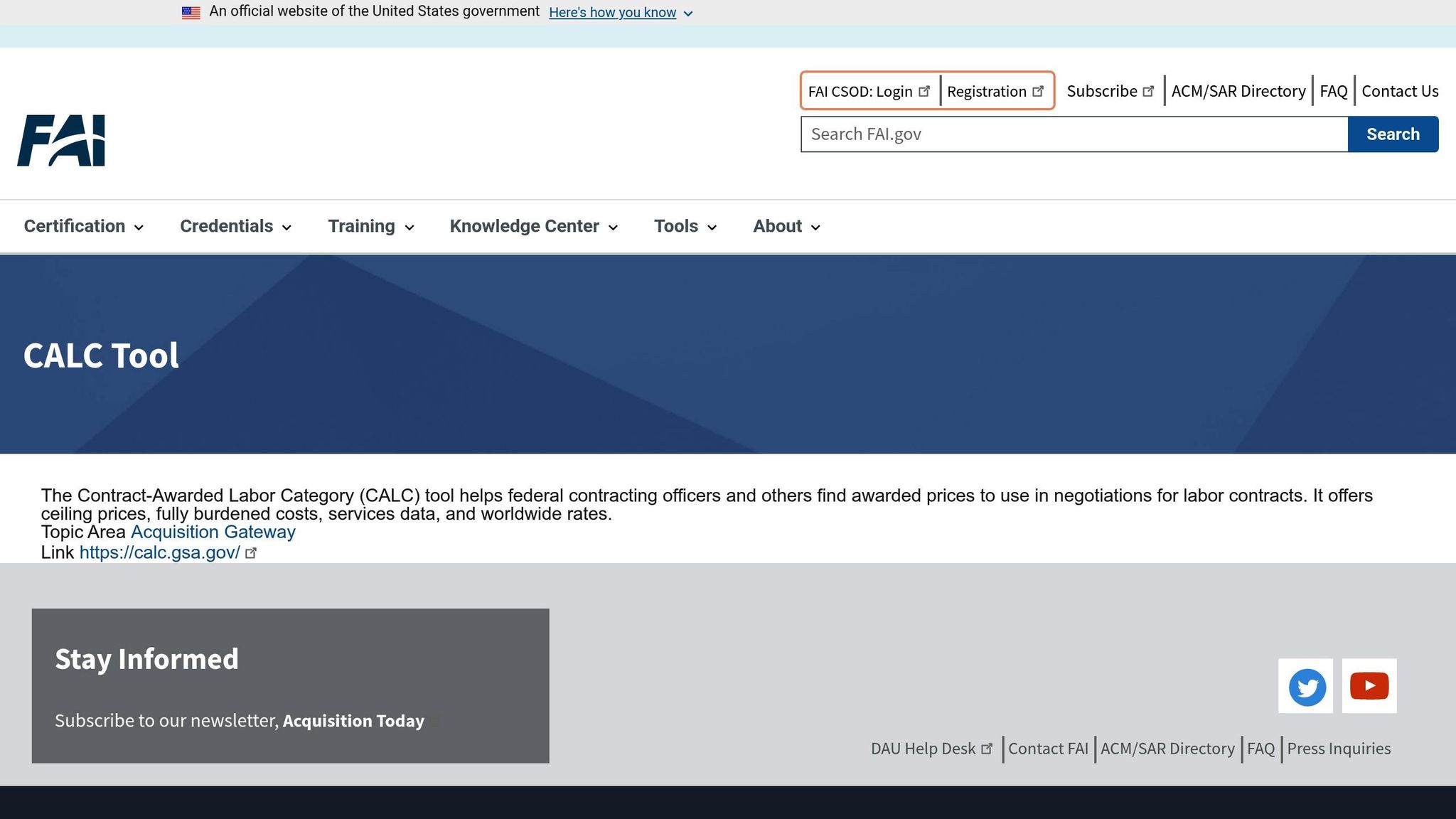
How to Choose GSA Pricing Benchmark Data Sources
When it comes to competitive pricing for GSA contracts, selecting the right benchmark data sources is a critical step. To meet GSA’s quality standards, your data sources should uphold principles like utility, objectivity, integrity, transparency, and reproducibility. Together, these attributes create a solid foundation for determining competitive and compliant pricing.
Accuracy and Objectivity
At the heart of reliable benchmark data are accuracy and objectivity. As GSA explains:
Objectivity involves a focus on ensuring that information is accurate, reliable and unbiased and that information products are presented in an accurate, clear, complete and unbiased manner.
It’s essential to choose sources that use rigorous methodologies. This is especially important when you consider that in 2024, 42% of failed GSA offers were linked to mismatched labor categories or pricing. Reliable data can help avoid such pitfalls.
Recency of Data
Timeliness is another key factor. GSA pricing doesn’t fluctuate as often as commercial markets because it’s based on pre-negotiated ceiling rates under the Multiple Award Schedule (MAS). To ensure your rates are competitive, rely on recent historical contract data to validate your pricing.
Federal Relevance
Your data sources must align with the specific needs of federal procurement. This means focusing on federal-specific costs and capturing actual agency pricing. Using irrelevant or generalized data can lead to noncompliance and missed opportunities.
Transparency and Reproducibility
Transparency is non-negotiable. Data sources should be well-documented, with detailed methodologies that meet GSA’s standards for transparency and reproducibility. This level of openness allows third parties to understand and replicate your results, which strengthens your case during contract negotiations.
Compliance with FAR Standards
Federal Acquisition Regulation (FAR) compliance is another critical consideration. The data you use must support the fair and reasonable pricing standards that GSA applies when evaluating proposals.
Scope and Coverage
The breadth of your data sources matters. Comprehensive coverage helps you uncover opportunities across various Special Item Numbers (SINs) and ensures you’re not missing key market insights.
Documentation and Auditability
Your benchmark data should come with clear documentation and a traceable audit trail. This includes tracking pricing assumptions, wage rates, and discounts. Having auditable records ensures you can justify your pricing decisions when scrutinized.
Update Frequency and Maintenance
The market evolves, and so should your data. Choose sources that are regularly updated to ensure your market intelligence stays relevant and accurate.
Analytical Capabilities
Finally, your data sources should offer robust analytical tools that align with your pricing strategy. Look for features that allow you to compare labor rates, analyze historical contracts, and identify trends. As iQuasar LLC puts it:
Mastering GSA pricing isn’t just about submitting compliant numbers – it’s about building trust with federal buyers through transparency, consistency, and strategic value.
1. GSA eLibrary
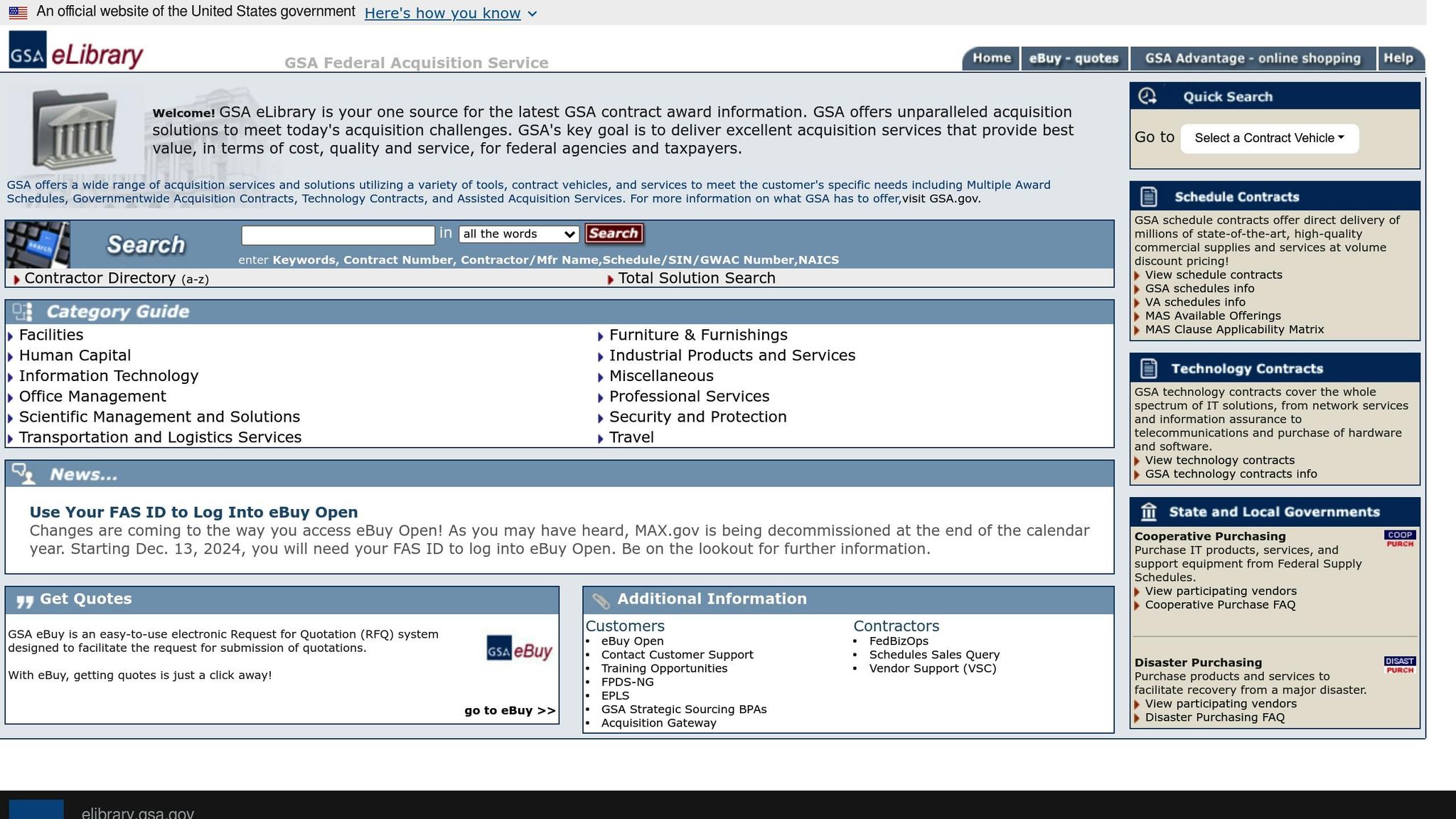
The GSA eLibrary is an online resource that houses contract award information managed by the General Services Administration (GSA). This platform is a treasure trove for diving into pricing trends, offering insights to shape your GSA Schedule proposal. By tapping into this data, you can build a solid understanding of pricing benchmarks, which we’ll explore further in the following sections.
Accuracy of Pricing Data
One of the platform’s key strengths is its ability to provide precise pricing benchmarks. It showcases hourly ceiling rates – essentially the upper limits for pricing. However, it’s common for actual task order awards to reflect negotiated rates that are lower than these ceilings. This makes the eLibrary an essential tool for setting realistic, competitive pricing strategies.
Relevance to Federal Contracting
For those navigating federal procurement, the GSA eLibrary is indispensable. It allows users to search by contractor name, contract number, or Special Item Numbers (SINs), giving you a clear view of competitors’ pricing and contract details. Whether you’re reviewing GSA Multiple Award Schedule (MAS) contracts, GSA Technology Contracts, or VA Schedule Contracts, the platform is a go-to resource for both government buyers and contractors. Its intuitive interface further simplifies the process, making it easier to extract meaningful insights.
Transparency and Ease of Access
The eLibrary stands out for its ease of use and transparency. You can search by contract number, contractor name, SIN, or even keywords to uncover detailed contract profiles. Once you select a contractor or SIN, the platform provides a wealth of information: contract numbers, performance periods, contact details, awarded SINs (with direct links to pricelists), socioeconomic indicators, and scope descriptions complete with applicable limitations. This level of detail not only saves time but also makes competitive analysis far more efficient.
Recency of Available Information
Keeping up with market dynamics is crucial, and the GSA eLibrary delivers on this front. It features up-to-date, validated contract and vendor data, reflecting the latest awards, modifications, and SIN additions. The platform’s dynamic updates ensure you’re always in the loop when it comes to changes in the federal contracting landscape, helping you stay ahead of the competition.
2. GSA Advantage
GSA Advantage operates as an online shopping and ordering platform, giving users access to GSA Schedule holders. It’s not just a marketplace; it’s a critical resource for establishing pricing benchmarks in federal procurement.
Accuracy of Pricing Data
The pricing data on GSA Advantage plays a key role in federal purchasing decisions. In fact, GSA uses this data as one of the tools to calculate market thresholds for pricing analysis. This means the platform doesn’t simply list prices – it actively shapes the government’s understanding of fair market value.
That said, GSA doesn’t rely on GSA Advantage alone. It incorporates other sources like open market pricing for Commercial Off-the-Shelf (COTS) items, Transactional Data Reporting (TDR) data, and Consumer Price Index (CPI) data to evaluate pricing reasonability. While competitor pricing on GSA Advantage is a strong reference point, it’s just one part of a much larger pricing evaluation process. This comprehensive approach highlights how GSA Advantage contributes to the broader federal contracting landscape.
Relevance to Federal Contracting
For contractors aiming to fine-tune their pricing strategies, GSA Advantage offers real, measurable benefits. For instance, schedule contracts save federal agencies an average of 15–25% compared to open-market purchases. This underscores the platform’s role in delivering cost savings to government buyers.
Contractors also use GSA Advantage to benchmark competitors and validate their own pricing. The platform’s extensive database allows users to analyze how competitors within their Special Item Numbers (SINs) price and position similar products or services. This kind of competitive analysis is essential, especially when you consider that in 2024, 42% of failed GSA offers were due to labor category mismatches or pricing issues. The insights gained from GSA Advantage can help contractors avoid these pitfalls.
Transparency and Ease of Access
One of GSA Advantage’s standout features is its transparent and easily accessible pricing information, making it an invaluable tool for federal contracting opportunities. The platform acts as an interactive electronic system, providing online access to vendors’ schedule prices alongside detailed ordering information.
Anyone with a standard web browser can access GSA Advantage. Even better, the platform is open to the public, allowing anyone to browse and compare products and services. This openness makes it a go-to resource for market research and competitive analysis.
Its search functionality also sets it apart. Users can search by manufacturer, part number, or product category, making it easy to find specific items or conduct broader market research. This search-driven approach supports targeted research and helps users stay competitive in federal procurement.
Recency of Available Information
GSA Advantage ensures that its pricing data is up-to-date, reflecting current market trends. This real-time information helps both contractors and government buyers make informed decisions. By keeping its data current, the platform supports market threshold calculations and ensures competitiveness in procurement activities.
This commitment to providing fresh data aligns with GSA’s mission to "ensure the best value for federal partners". It offers a reliable foundation for pricing decisions, benefiting both government agencies and contractors participating in the GSA Schedule program.
3. CALC (Contract-Awarded Labor Category) Tool
The CALC Tool is a dedicated database designed to provide federal labor pricing benchmarks. Unlike broader procurement tools, CALC zeroes in on hourly rates for professional services, making it a go-to resource for service-based GSA Schedule holders.
Accuracy of Pricing Data
CALC delivers all-inclusive hourly rates – fully burdened figures that cover overhead, profit, and benefits – from awarded MAS contracts. These are actual rates, not estimates, ensuring precise data for users.
The tool allows users to filter results based on key criteria like education, experience, security clearance, and contract year. With thousands of labor categories available, ranging from Program Managers to Cybersecurity Analysts, CALC offers comprehensive coverage.
Relevance to Federal Contracting
One of CALC’s key strengths is its ability to validate labor rates against awarded government pricing. This feature is crucial for meeting fair and reasonable pricing requirements. When evaluators review pricing proposals, they can rely on CALC to ensure rates align with market standards.
The tool offers two main search options:
- Hourly Labor Ceiling Prices
- Prices Paid (restricted to authorized federal employees and contractors with .gov or .mil email domains).
Transparency and Ease of Access
CALC is designed with user accessibility in mind, without compromising data quality. It presents actual awarded rates rather than estimates. To get the most accurate results, users should apply all relevant filters and carefully review the number of data points returned in each search.
Recency of Available Information
One standout feature of CALC is its real-time data updates. Unlike other tools that refresh monthly, CALC updates immediately when a new MAS contract is awarded. This ensures users always have the latest market data at their fingertips.
Compared to tools like GSA Advantage or eLibrary, which focus on product listings or contract documentation, CALC provides real-time access to fully burdened hourly ceiling rates from awarded MAS contracts. For added accuracy, users can cross-check CALC data with GSA eLibrary, GSA Advantage, and FPDS.
4. GSA eBuy
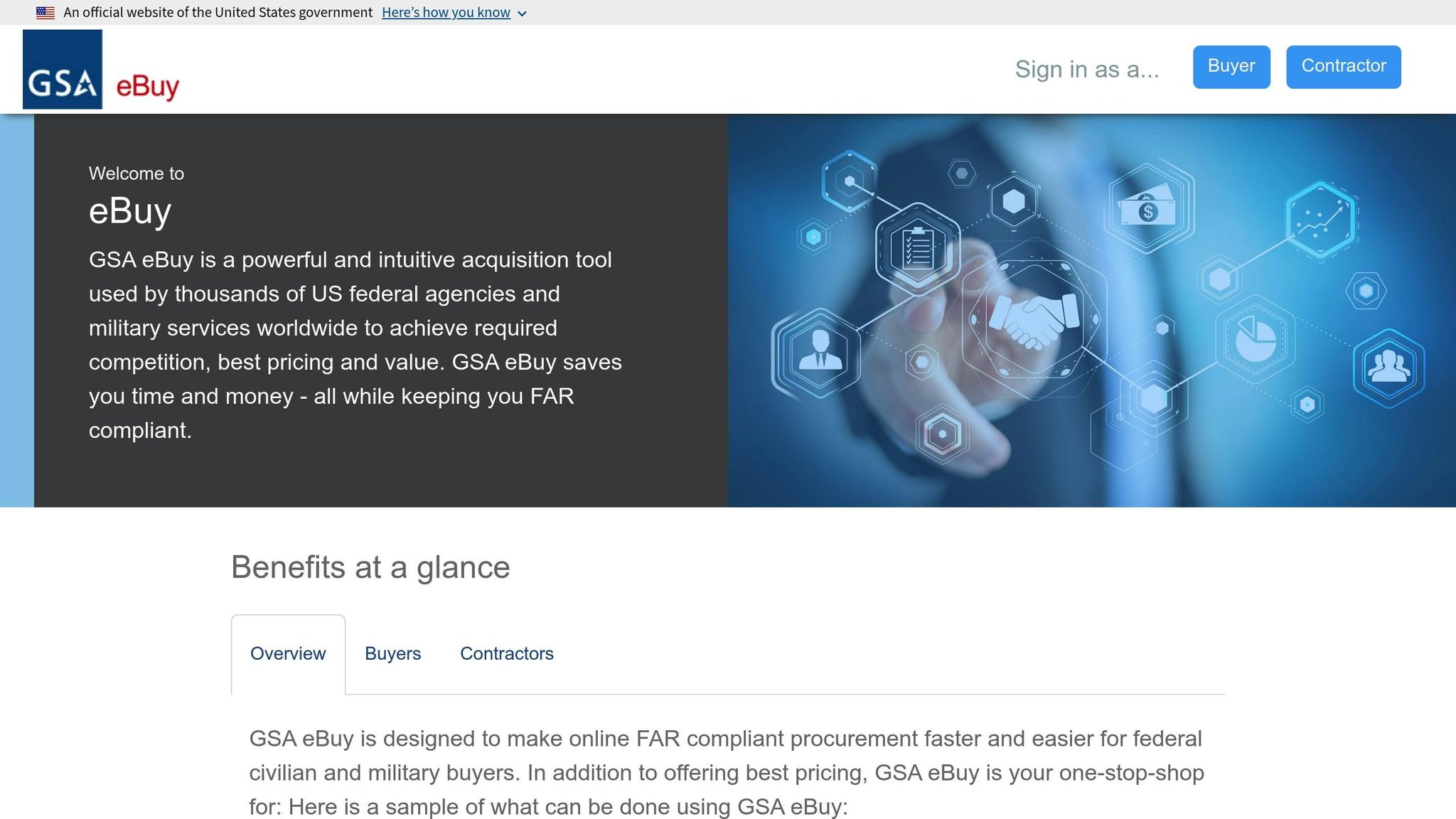
GSA eBuy operates as a dynamic RFQ/RFP system, connecting federal agencies with contractors through a competitive bidding process. Unlike static pricing databases, this platform offers real-time market insights by showcasing actual quotes and proposals submitted for ongoing procurement opportunities.
Accuracy of Pricing Data
The pricing data on GSA eBuy reflects real-world market competition, not just theoretical estimates. When agencies post their requirements, contractors respond with quotes that mirror current market trends, adjusting naturally to supply and demand.
"eBuy encourages contractor participation, leading to competitive quotes and facilitating informed decisions that offer the best value for buyers." – federalcompass.com
With over 1.2 million RFQs and RFPs processed annually and opportunities totaling more than $55 billion each year, the platform provides a wealth of data that genuinely represents market conditions across a wide range of federal procurement categories.
Relevance to Federal Contracting
GSA eBuy plays a key role in federal contracting by enabling competitive bidding. It consolidates solicitations from multiple agencies, simplifying the process for contractors to find relevant opportunities and understand current market rates. The platform is well-suited for handling complex procurement needs, especially for contracts exceeding the simplified acquisition threshold of $250,000. Agencies can also attach detailed statements of work and request pricing for Blanket Purchase Agreements (BPAs).
Transparency and Ease of Access
More than 17,000 federal, state, and local government agencies actively use GSA eBuy, creating a robust marketplace for procurement. Buyers access the platform through GSA Advantage credentials, ensuring seamless integration with other GSA tools. The process for posting RFQs involves four straightforward steps: Search, Select, Prepare, and Submit. Additionally, users can filter opportunities by socio-economic designations, like small business set-asides, and utilize advanced search options – such as "Find all terms", "Find any of these words", and "Find exact phrase" – to quickly locate relevant opportunities.
Recency of Available Information
GSA eBuy is continually updated with new opportunities, ensuring its data remains current. The platform includes features like Q&A documents, which allow agencies to clarify requirements and share additional information with all bidders. By August 2025, GSA eBuy plans to roll out updates that will let buyers clearly specify whether they’re requesting quotes (RFQs), proposals (RFPs), or information (RFIs), enhancing communication and reducing ambiguity. The "My RFQs" feature centralizes active opportunities for easy management, while the Forward RFQ function supports team collaboration on complex procurements. These real-time updates make GSA eBuy an indispensable tool for accessing accurate and timely procurement data, further enriching our understanding of essential GSA pricing resources.
5. SAM.gov
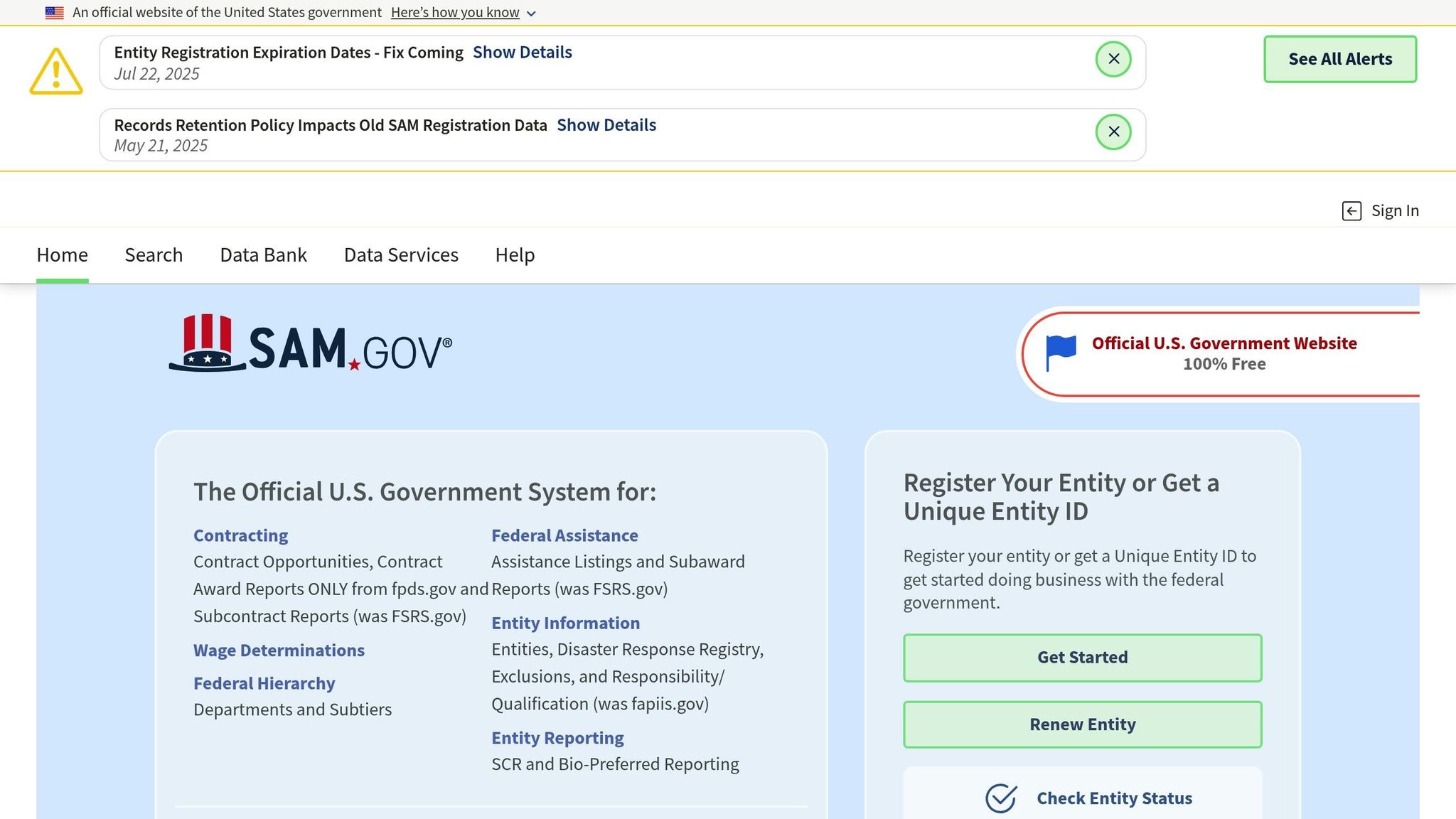
SAM.gov serves as the official platform for managing federal awards in the United States. It consolidates various legacy systems into a single source, offering access to contract opportunities, award details, and pricing data. For instance, it provides information on contracts valued at $10,000 or more, making it a vital tool for understanding federal procurement trends. This centralized resource complements other General Services Administration (GSA) pricing tools by offering detailed insights into federal awards.
Accuracy of Pricing Data
The pricing data on SAM.gov is derived from actual contract awards and incorporates Transactional Data Reporting (TDR). Vendors are required to submit 16 transactional data elements each month, including unit prices and total costs. This data is then made accessible through the Vendor Support Center, offering transparency into top-selling products and services. Additionally, the GSA enforces a pricing standard, limiting annual price increases for category items to 10% unless a valid justification is provided.
Relevance to Federal Contracting
SAM.gov is indispensable for businesses aiming to work with the U.S. government. It is the mandatory registration portal for federal contracting and allows users to search for opportunities – typically those exceeding $25,000 – using criteria like NAICS codes, set-aside designations, and location of performance. This makes it a key resource for pricing research across various industries. Furthermore, GSA Schedule procurements are processed through SAM.gov, adding to its importance in understanding federal market pricing.
Transparency and Ease of Access
SAM.gov not only identifies contract opportunities but also simplifies research with its robust reporting tools. Through its Data Bank, users gain access to 36 standard reports and 6 administrative contract data reports. Importantly, registration on the platform is free, making these resources widely accessible.
Recency of Available Information
The platform is regularly updated based on user feedback and changes in federal requirements. This ensures that the contract award data on SAM.gov reflects the latest market conditions, keeping users informed and aligned with current trends.
sbb-itb-8737801
6. Acquisition Gateway
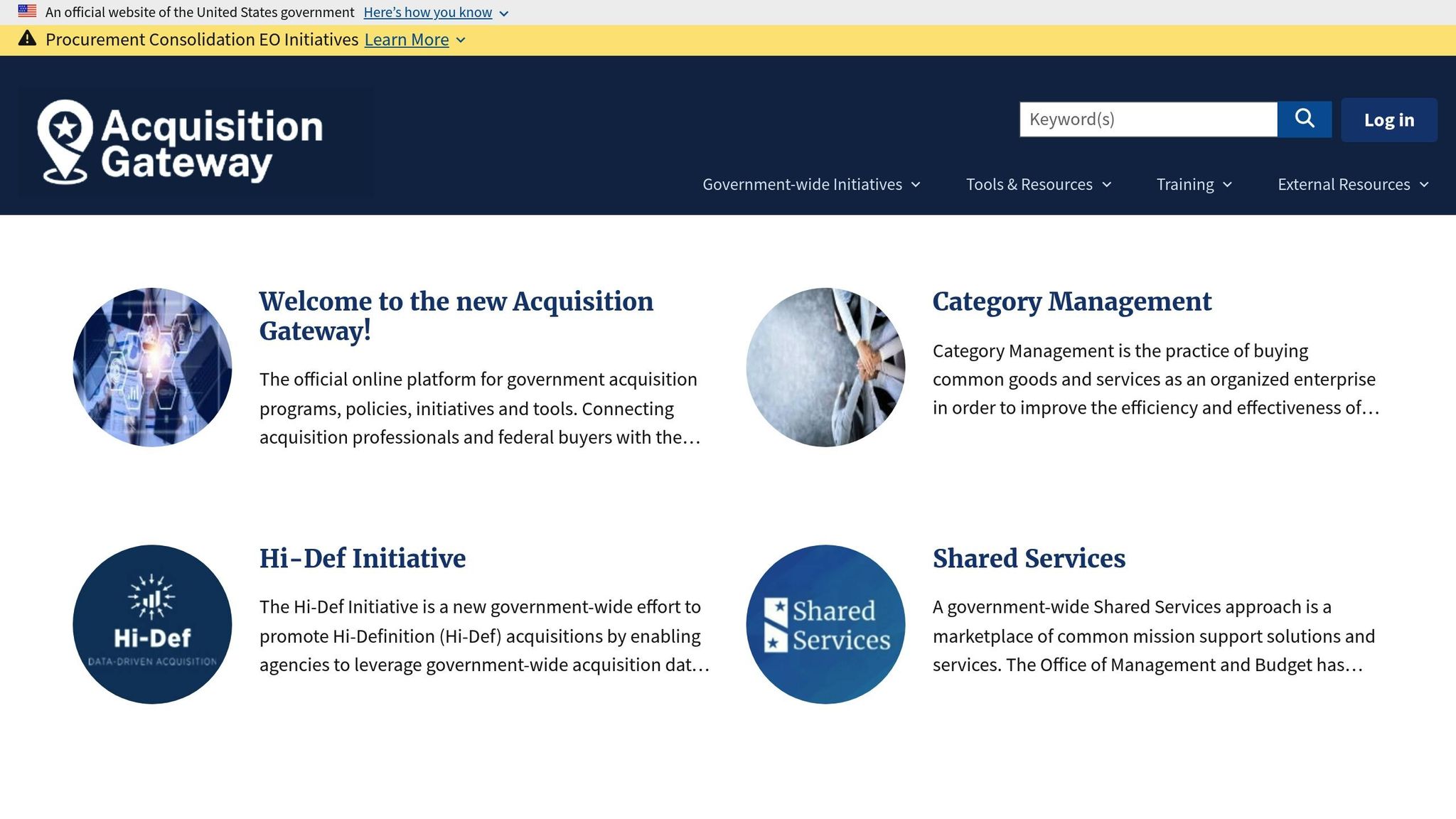
The Acquisition Gateway supports federal acquisition processes by connecting procurement professionals and federal buyers with essential pricing data and market research tools. This platform complements other tools by offering real-time analytics that are critical for competitive federal contracting.
Relevance to Federal Contracting
The Acquisition Gateway strengthens federal procurement strategies by providing timely and actionable pricing data. A key feature is its Hi-Def Initiative, managed by GSA, which facilitates "Hi-Definition" acquisitions. This initiative allows agencies to access relevant acquisition data whenever needed, streamlining the process of crafting competitive GSA Schedule proposals. Additionally, the Procurement Co-Pilot tool uses Hi-Def data – such as prices paid, vendor details, and contract specifics – to enhance market research and improve decision-making.
Accuracy of Pricing Data
Pricing data on the Acquisition Gateway combines vendor-submitted TDR (Transactional Data Reporting) with information from FPDS (Federal Procurement Data System) and the GSA FAS (Federal Acquisition Services) Catalog. The Professional Services Category actively supports expanding TDR within the GSA MAS (Multiple Award Schedule) program. In 2025, this category developed methods to capture MAS contract labor data and verify its quality. For labor hour and time-and-materials contracts, vendors provide detailed breakdowns of hourly rates by labor category. This data is further enriched with additional details from FPDS and the GSA FAS Catalog Platform, ensuring a comprehensive view of pricing.
Recency of Available Information
The Acquisition Gateway ensures its pricing data stays up-to-date through regular updates. For example, in February 2025, the Acquisition Analytics Dashboard was upgraded to pull commercial benchmark comparisons more frequently. This enhancement followed a cost avoidance and price analysis conducted by the Office Management Category for the OS4 Best In Class solution in FY24, which confirmed its competitiveness even during inflationary periods. By the end of FY24, the match rate between reported line items and contract catalog data reached 78.6%, and for products specifically, it climbed to 94.8%, reflecting significant improvements in data accuracy.
Transparency and Ease of Access
The Acquisition Gateway promotes transparency by offering federal acquisition data through various analytical tools. One of its key features, the Acquisition Analytics Dashboard, enables agencies to compare government solutions with commercial "open market" pricing, helping them make better-informed procurement decisions. More frequent pricing comparisons have boosted the accuracy of cost savings estimates. For instance, OS4 and MRFS2 solutions accounted for nearly $20 million in savings in FY24, factoring in spending, cost avoidance, and inflation. The platform also includes the Periodic Table of Acquisition Innovations (PTAI), a collaborative initiative between government and industry. This feature highlights tested business practices and technologies, supporting competitive and compliant pricing for GSA contracts.
7. USASpending.gov
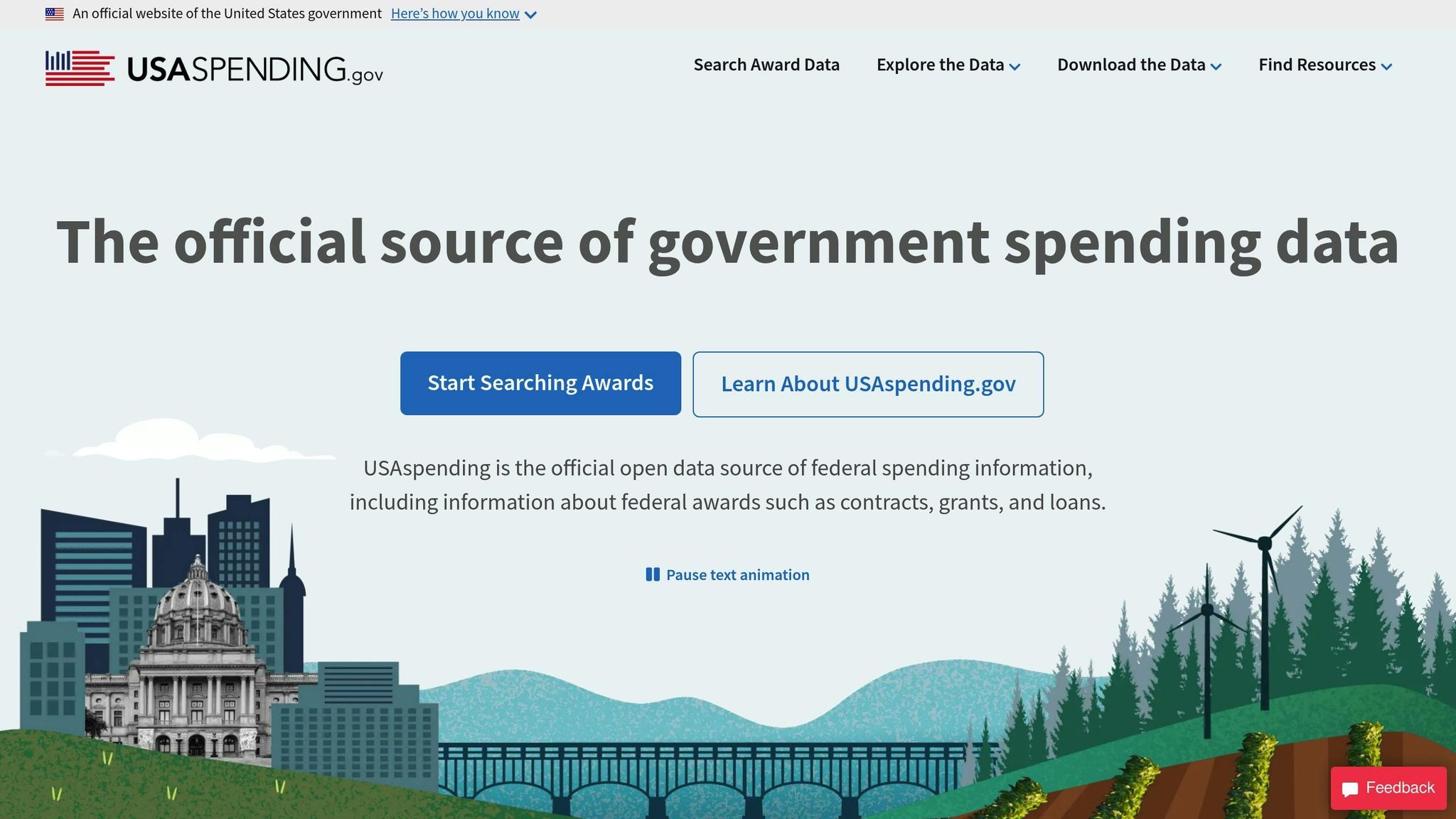
USASpending.gov serves as the official hub for federal spending data on grants and contracts [55, 58]. It offers contractors access to annual federal spending data, which is indispensable for market research and competitive pricing analysis. This information plays a key role in shaping effective GSA pricing strategies.
Relevance to Federal Contracting
For government contractors, USASpending.gov is a treasure trove of details about federal awards. Users can explore award information such as the recipient, amount, date, awarding agency, and specific filters like industry or small business categories. This data is invaluable for researching past awards, identifying competitors, and analyzing agency spending habits – insights that directly inform GSA Schedule pricing strategies. When used alongside tools like GSA eLibrary and SAM.gov, USASpending.gov provides a more comprehensive view of federal spending trends.
Accuracy of Pricing Data
While USASpending.gov is a critical resource, its data isn’t without flaws. A November 2023 report from the Government Accountability Office (GAO) highlighted several issues. For example, 25 executive branch agencies didn’t report their data to USASpending.gov for FY2022. Even among those that did, discrepancies were found, such as mismatched COVID-19 obligation figures compared to their budgets and annual financial reports. The report also flagged problems with grant subaward data, including missing details, inflated subaward values, and duplicate records. GAO estimated that only 2%–7% of awards fully matched agency records across all 21 data elements.
Transparency and Ease of Access
USASpending.gov is designed to give taxpayers and contractors a clear view of how federal funds are spent. For example, when searching by congressional district (CD), users should be aware that district boundaries can shift significantly during decennial redistricting. The platform allows searches using either "original" (pre-2023) or "current" (2023-onward) boundaries. Additionally, for location-specific research on grants and contracts, searching by the place of performance yields more accurate results. While the interface is straightforward, users should remain mindful of potential gaps in the data.
Recency of Available Information
Although USASpending.gov is regularly updated with federal spending data, there may still be gaps in the search results. To ensure accurate analysis, contractors should cross-reference this information with other data sources. Given the known issues with data quality, USASpending.gov is best used as one piece of a larger research strategy, helping contractors build more reliable pricing benchmarks.
8. Federal Procurement Data System (FPDS)
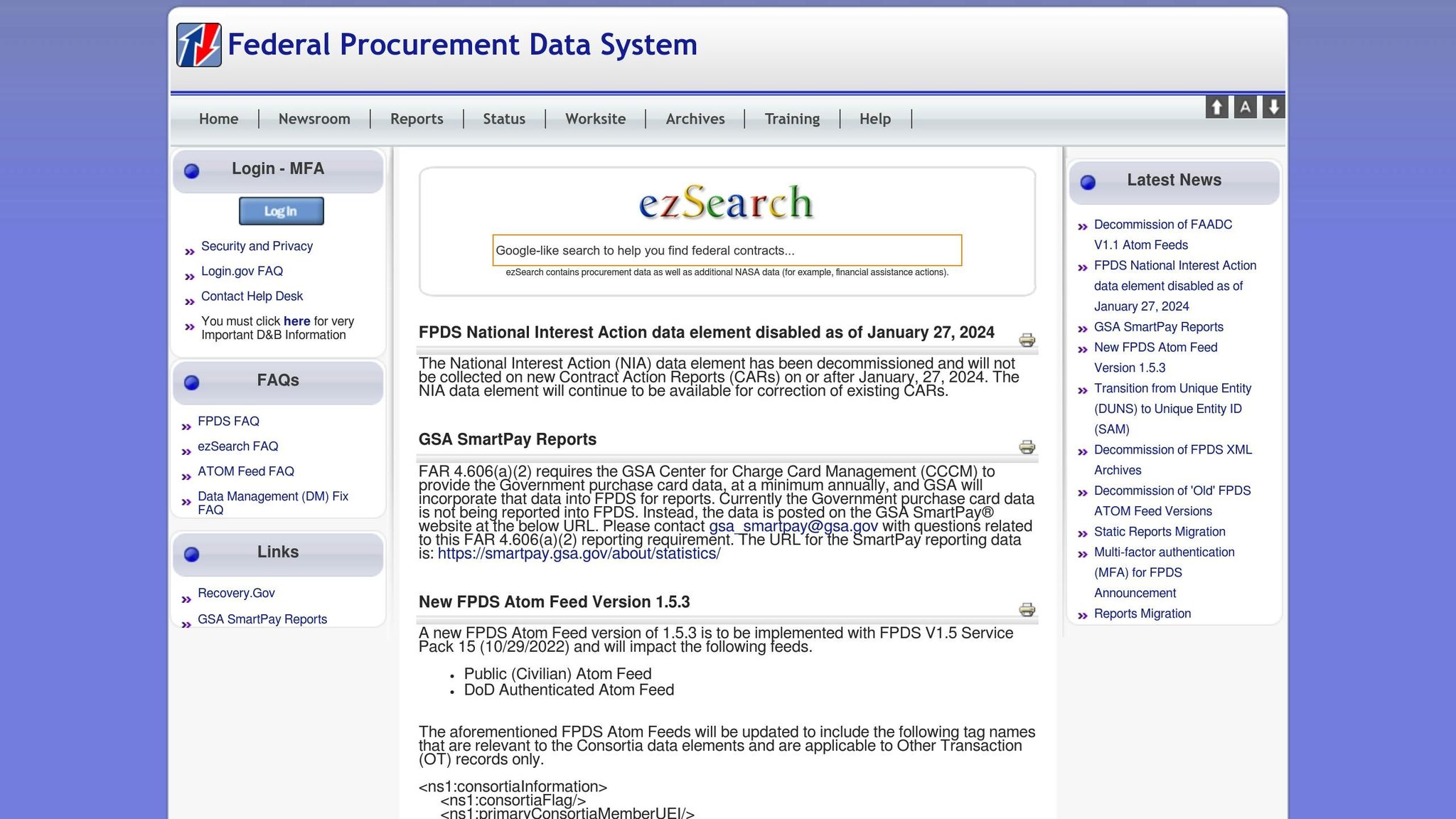
The Federal Procurement Data System (FPDS) is the go-to database for federal contracting information. It serves as a detailed repository that tracks federal contract actions and procurement trends, offering contractors critical insights for refining their GSA pricing strategies. As a real-time, relational database, FPDS is the definitive source of contract data for the entire government acquisition community.
Relevance to Federal Contracting
FPDS provides an extensive archive of federal contracts, with approximately 200,000 contracts spanning 30 years and covering over 60 agencies. Federal regulations require that any contract with an awarded value of $10,000 or more be reported in FPDS, ensuring it captures a broad spectrum of procurement activities.
For contractors fine-tuning their pricing strategies, FPDS is a goldmine of information. For instance, in fiscal year 2024, the Department of Defense alone submitted over 89 million contract actions to FPDS, totaling obligations of more than $445 billion. This vast dataset helps contractors analyze competitors’ performance, understand bidding trends, and identify areas where they can improve.
FPDS also serves as a resource for market intelligence, shedding light on the products and services federal agencies are seeking and highlighting historical supplier relationships. Contractors can use this data to identify high-demand offerings and shape their proposals to align with federal needs.
"Making data-driven decisions and providing spending transparency to the public requires our timely and accurate data inputs at Federal Procurement Data System (FPDS)."
The system’s comprehensive coverage, along with strict federal reporting standards, makes it an indispensable tool for anyone involved in federal contracting.
Accuracy of Pricing Data
FPDS maintains high data quality through strict regulatory oversight. Under FAR Part 4.6, agencies must submit complete reports within three business days of contract award. Additionally, agencies are required to certify the accuracy of their data from the previous fiscal year by January 5.
This rigorous framework ensures that FPDS data is both reliable and up-to-date. Unlike secondary sources, which may experience delays or data gaps, FPDS operates in real time, allowing agencies to continuously update, correct, or modify contract actions without a cut-off date.
| FPDS | USASpending.gov |
|---|---|
| Primary source for government contracting data | Relies on FPDS as its data source |
| Real-time updates for continuous accuracy | Updates monthly, leading to potential delays |
| Certified annually for completeness and accuracy | Data quality depends on FPDS reporting |
| Advanced search and custom reporting options | Limited search and reporting capabilities |
Transparency and Ease of Access
Thanks to the Federal Funding Accountability and Transparency Act (FFATA), federal contract information is publicly accessible through FPDS. Users can access the full database by registering with an email at https://www.fpds.gov/.
"The Government needs to understand where tax dollars are spent."
FPDS promotes accountability and transparency, offering a user manual for guidance. Coupled with its real-time updates, FPDS ensures contractors and the public alike can stay informed about federal spending.
Recency of Available Information
One of FPDS’s standout features is its real-time updates, which provide the most current information on federal contracts. This gives it a clear edge over USAspending.gov, which refreshes its data monthly. By using FPDS, contractors can stay ahead of the curve, adjusting their pricing strategies to align with the latest federal procurement trends and spending patterns.
9. Transactional Data Reporting (TDR) Data
Transactional Data Reporting (TDR) is GSA’s most detailed approach to collecting pricing data from contractors. Unlike traditional methods that summarize sales data, TDR requires contractors to submit transaction-level information every month. This approach provides a deeper understanding of government purchasing patterns and pricing trends, making it an essential tool for setting competitive GSA pricing benchmarks.
Relevance to Federal Contracting
TDR has fundamentally changed how GSA manages federal procurement by capturing detailed data for every transaction. The system collects 15 specific data elements, such as contract numbers, item descriptions, manufacturer details, unit prices, and total transaction values. In July 2024, GSA expanded the program by adding four new data points: Order Date, Ship Date, Zip Code Shipped To, and Federal Customer. This additional information strengthens the program’s ability to create precise pricing benchmarks.
The program has grown significantly since its pilot launch in 2016. A major milestone came in August 2024, when GSA added 67 more Special Item Numbers (SINs) to TDR. This expansion highlights the program’s value in providing market insights that were previously unavailable to federal buyers.
"Expanding our use of Transactional Data Reporting will provide critical insights into pricing and procurement, ultimately ensuring taxpayer dollars are spent wisely." – Stephen Ehikian, GSA Acting Administrator
For contractors, TDR offers more than just compliance benefits. It eliminates the need to track Most Favored Customer (MFC) pricing and removes the administrative burden of the Price Reduction Clause (PRC). According to GSA, this reduces annual reporting costs by over $3,000 and saves 22 labor hours per contract.
Accuracy of Pricing Data
The monthly reporting requirement ensures TDR data reflects current market conditions. Submissions go through the GSA Sales Reporting Portal (SRP), which validates all data to maintain accuracy. Over time, the program has shown significant improvement in data reliability. For instance, the match rate for submitted data was 47.6% initially but rose to 78.6% overall – and an impressive 94.8% for products – by the end of fiscal year 2024.
This transaction-level detail provides a clearer picture of actual purchase prices, as opposed to theoretical catalog pricing. As a result, TDR offers a more precise foundation for pricing benchmarks.
| Aspect | TDR | Traditional CSP |
|---|---|---|
| Reporting Frequency | Monthly | Quarterly |
| Data Detail Level | Transaction-level (line-item) | Aggregate sales data |
| Data Points Collected | 15 elements (11 core + 4 new) | Discount and pricing data, incl. MFC |
| MFC Tracking Required | No | Yes |
| Price Reduction Clause | Not applicable | Applicable |
GSA takes a closer look at TDR data during contract renewals and awards, so maintaining accuracy is critical for contractors to stay competitive. Implementing robust internal audits and automating data collection can help minimize errors and ensure compliance.
Transparency and Ease of Access
TDR promotes transparency by making aggregated demand data available to the public through GSA’s Vendor Support Center. Updated every two months, these demand files highlight top-selling products across key categories. This level of access allows contractors to monitor market trends and adjust their pricing strategies based on real data.
In addition to sharing data, GSA uses TDR insights to provide contractors with targeted feedback about pricing competitiveness. This creates a more collaborative environment aimed at improving procurement outcomes across the board.
"Comprehensive data on purchased items and corresponding prices will empower our contracting officers to negotiate effectively and secure the best value for taxpayer dollars." – Josh Gruenbaum, Federal Acquisition Service Commissioner
Recency of Available Information
With its monthly reporting cycle, TDR ensures that pricing insights stay up to date with market conditions. This frequency gives GSA a significant edge over quarterly systems by enabling quicker identification of pricing trends and market changes. The real-time nature of TDR ensures that pricing benchmarks are based on actual, recent purchases rather than outdated catalog data.
For contractors, these monthly updates provide timely insights into high-demand products and services. This allows them to make informed decisions about pricing and product development based on real government purchasing behavior, rather than relying on assumptions .
10. GSA Focus

Specialized consulting services, like GSA Focus, simplify access to and understanding of GSA pricing benchmarks. This service is particularly helpful for small businesses looking to secure and manage GSA Schedule Contracts.
Relevance to Federal Contracting
In addition to databases like TDR and FPDS, GSA Focus provides tailored strategies for small businesses entering the federal procurement space. Their offerings include document preparation, compliance checks, and negotiation assistance, all designed to help businesses succeed in this complex environment. Led by founder Josh Ladick, whose industry expertise aids contractors in navigating federal pricing requirements, GSA Focus ensures that businesses can effectively use pricing benchmarks to their advantage.
For small businesses new to federal contracting, having an expert guide through the maze of pricing benchmarks can make a huge difference. This guidance not only simplifies the process but also ensures secure and clear access to critical market data.
Transparency and Ease of Access
GSA Focus supports the growing push for transparency in government purchasing. As the GSA moves closer to its goal of complete openness, services like those provided by GSA Focus are instrumental in helping contractors access and interpret available data.
To further this mission, GSA Focus offers a secure online platform for document uploads and maintains open communication throughout the contract acquisition process. This aligns with the GSA’s broader efforts to make purchasing data more accessible to industry players. Additionally, GSA Focus helps contractors interpret the demand data that the GSA shares every two months via the Vendor Support Center. These insights are essential for developing effective pricing strategies and market approaches.
Staying Current with Federal Procurement
GSA Focus remains up-to-date with changes in federal procurement policies and data sources. They continuously adapt their advisory services to reflect the latest federal pricing data, ensuring that contractors can adjust their pricing strategies to align with shifting market conditions and new data programs. This commitment to staying current helps businesses remain competitive in the federal marketplace.
Using Comparison Tables for Data Sources
Having accurate market intelligence is a cornerstone for setting competitive GSA pricing. By reviewing all ten data sources and organizing them into a clear comparison table, you can simplify your evaluation process and make informed pricing decisions. This structured approach connects detailed data analysis directly to actionable pricing strategies, making it easier to align with GSA expectations.
This method aligns closely with the GSA’s own analytical processes when assessing proposals.
Key Factors for Comparison
When creating your comparison table, focus on several critical criteria that directly influence your ability to craft competitive GSA pricing:
- Data Type and Scope: Identify whether the source provides information like contract awards, labor rates, or transactional data. This ensures you’re pulling the right kind of data for your needs.
- Update Frequency: Understand how often the data is refreshed. In fast-changing federal markets, up-to-date information is essential for staying competitive.
- Ease of Access: Evaluate how quickly and easily you can access the data. For instance, public platforms like GSA eLibrary offer immediate access, while others may require registration or specific tools to navigate.
- Federal Relevance: Assess how well the data reflects government purchasing patterns. This is crucial for aligning your pricing with federal standards.
- Data Limitations: Highlight any gaps or biases in the data. Knowing these limitations can help you account for them in your analysis.
Here’s an example of how these factors might look in a comparison table:
| Data Source | Data Type | Update Frequency | Access Level | Federal Relevance | Limitations |
|---|---|---|---|---|---|
| GSA eLibrary | Contract awards, pricing | Real-time | Public | High | Limited historical data |
| CALC Tool | Labor categories, rates | Quarterly | Public | High | Services-focused only |
| USASpending.gov | Contract spending | Daily | Public | High | Aggregated data only |
| TDR Data | Transaction details | Monthly | Restricted | Very High | GSA Schedule only |
Making Data-Driven Comparisons
The GSA relies on a mix of market research, commercial price comparisons, and transactional data analysis to evaluate pricing. Your comparison table should reflect this approach by considering multiple factors at once, rather than focusing on a single metric. For example, weigh the cost of accessing specialized data against the time savings and improved accuracy it offers.
Combining Data Sources for Broader Insights
Your table should also help you assess how different sources complement one another. The GSA often examines pricing trends across multiple vendors to ensure rates remain competitive. By using your table to identify the strongest source combinations, you can gain a more comprehensive view of the market. With these insights, you’ll be better equipped to refine your pricing strategy through targeted data comparisons.
Conclusion
Setting competitive GSA Schedule pricing requires a well-planned, data-driven strategy. Marissa Sims, Lead Consultant for Winvale, highlights the importance of this approach:
"Pricing is a crucial aspect of a GSA Schedule, so much so that there is a dedicated pricing section in your proposal. It demands a focused and well-thought-out strategy".
To craft a winning proposal, tools offering real-time insights and historical spending data are indispensable. Market research in the GSA Schedule landscape zeroes in on goods and services sold through pre-negotiated, government-approved contracts. This focus is vital for understanding the unique dynamics of federal procurement, where GSA Schedule contracts typically save agencies 15–25% compared to open-market purchases. Such insights form the backbone of strong pricing strategies.
Consistent market research keeps contractors both compliant and competitive. By regularly analyzing the market, contractors can make informed updates to their catalogs, identify the best opportunities, and adapt to changing market conditions.
For small businesses, GSA Focus simplifies the contract acquisition process with tailored services. From document preparation to compliance checks and negotiation support, they provide the tools and guidance needed to confidently navigate federal contracting opportunities.
FAQs
How can small businesses use data sources to set competitive GSA Schedule pricing and win contracts?
Small businesses looking to stay competitive in their GSA Schedule pricing should tap into dependable data sources like GSA CALC and GSA datasets. These tools offer a clear window into pricing trends and market norms, giving businesses the guidance they need to align their pricing with federal standards.
By digging into this data and performing detailed market research, businesses can craft proposals that not only emphasize value but also address buyer priorities. This proactive strategy can make their offerings more appealing and boost their chances of landing GSA contracts.
What challenges might arise when using data sources for GSA pricing benchmarks?
When relying on data sources for GSA pricing benchmarks, several hurdles can arise. One major concern is data quality – issues like errors, missing details, or inconsistent formats can make benchmarks less reliable. Since GSA depends on agencies to provide accurate data, delays or mismatches in reporting can also impact the accuracy and timeliness of the information.
These challenges can complicate efforts to establish precise pricing or maintain compliance with GSA requirements. To reduce these risks, it’s crucial to thoroughly assess the dependability of your data sources and, whenever possible, cross-check the information for consistency.
Why is using recent data important for GSA pricing strategies, and which sources provide the latest insights?
Staying on top of recent data is key to crafting effective GSA pricing strategies. Why? Because relying on outdated information can lead to missteps – pricing too high might cost you valuable opportunities, while pricing too low can eat into your profits.
Here are some trusted sources for the latest GSA pricing insights:
- GSA datasets: Updated as of January 14, 2025.
- GSA pricing audit trends: Latest data available from February 4, 2025.
- Competitor pricing analysis: Most recent update on February 9, 2025.
Tapping into these resources allows you to base your pricing decisions on the most current market conditions, ensuring your strategies align with federal contracting standards.
Related posts
- How to Analyze GSA Competitor Pricing
- 5 Tools for GSA Competitor Research
- How to Set GSA Prices for Federal Contracts
- 5 Tools for GSA Competitor Pricing Research


